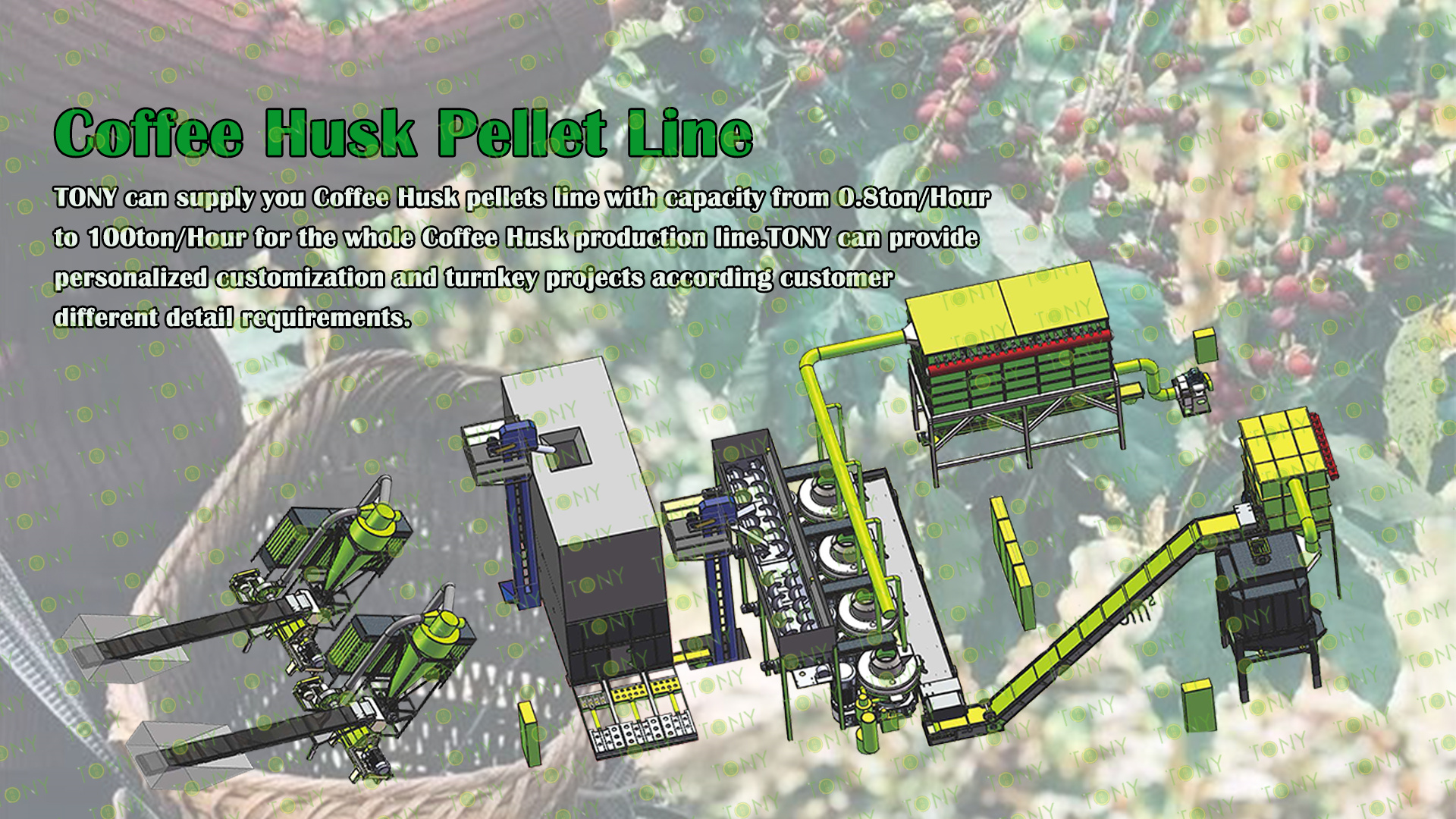
TONY Design 12-15Ton/Hour Coffee Husk Production Line Specification
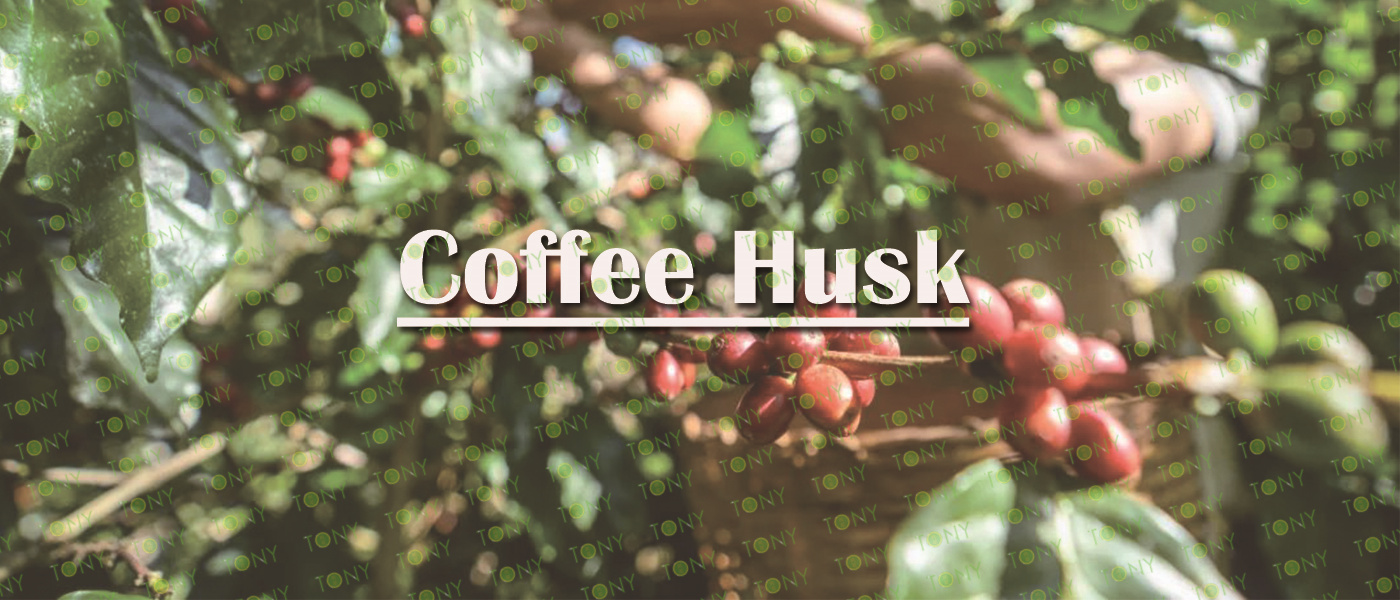
Coffee shell resources are mainly distributed in countries such as Brazil, Colombia, Indonesia, Jamaica, Costa Rica, Ethiopia, Vietnam, India and China.
Distribution of major coffee producing countries:
Brazil: Brazil is the largest coffee producer in the world, with an annual output of more than 30 million bags of coffee beans. Brazilian coffee is mainly distributed in the Brazilian plateau and southern regions.
Colombia: Colombia is the world’s largest producer of high-quality Arabica washed coffee, with an annual output of 13 million bags.
Indonesia: Javanese coffee produced in Indonesia was once synonymous with coffee and was mainly distributed on the island of Java.
Jamaica: Jamaican coffee is famous for Blue Mountain coffee, which is mainly grown in the Blue Mountains.
Costa Rica: Costa Rica is a traditional coffee producer in the world, and its coffee is sold overseas.
Ethiopia: Ethiopia is the origin of coffee and has a long history of coffee production.
Vietnam: Although Vietnam is a small country, it has fertile land and a climate suitable for growing coffee beans.
India: India is a country that traditionally produces coffee and has high coffee production.
China: China has coffee cultivation in Yunnan, Hainan and other places. Yunnan caffeine is famous for its unique geographical environment and climatic conditions.

1. Environmental Value
Coffee husk is the main waste in the coffee processing process. Making it into granules is an environmentally friendly treatment method. The global coffee production is huge, and a large amount of husk will be generated during the processing of coffee beans. If these husks are discarded at will, it will cause environmental pollution, such as producing peculiar smell due to decay and breeding harmful microorganisms. Making coffee husks into granules can effectively recycle these wastes. For example, in some major coffee-producing countries such as Brazil and Colombia, coffee husks used to be often piled up around coffee processing plants, occupying land and polluting the environment. Now, by processing them into granules for uses such as composting, the environmental pressure is reduced.
2. As A Fertilizer
Coffee husk is rich in nutrients. It contains a large number of elements such as nitrogen, phosphorus, and potassium, which are necessary for plant growth. Among them, nitrogen is helpful for the growth of plant branches and leaves. Phosphorus plays an important role in the development of plant roots and flowering and fruiting. Potassium can improve the stress resistance of plants.
Granular fertilizer is convenient for storage and transportation. Compared with unprocessed coffee husk, granular fertilizer is more compact and takes up less space. Moreover, during fertilization, granular fertilizer is easier to control the dosage and can be spread more evenly on the soil surface or mixed into the soil. For example, in flower plantations or vegetable planting bases, using granular coffee husk fertilizer can be conveniently fertilized through fertilization equipment.
3. In Terms Of Energy Production
Coffee husk granules can be used as raw materials for bioenergy. Through some special processing technologies such as pyrolysis or anaerobic fermentation, coffee husk granules can be converted into biochar or biogas. Biochar can be used for soil improvement, increasing the carbon content of the soil, improving soil fertility, and being able to adsorb harmful substances in the soil. Biogas can be used as a clean energy for power generation or heating.
4. Application In Animal Feed
After proper treatment, coffee husk granules can be used as ingredients in animal feed. Coffee husk contains a certain amount of cellulose and other nutrients. Adding coffee husk granules to the feed of some ruminants (such as cattle and sheep) can increase the fiber content of the feed and help the digestion of animals. However, it should be noted that coffee husk contains some components (such as caffeine, etc.). If the content is too high, it may have adverse effects on animals. Therefore, coffee husk needs to be reasonably processed and proportioned when making animal feed granules.

1.The main factors affecting the yield of coffee husk pellets include raw material selection, raw material pretreatment, equipment configuration and ratio adjustment.
First of all, raw material selection is one of the key factors affecting the yield of coffee Husk pellets. The type and quality of raw materials directly affect the output and quality of pellets. For example, when coffee husk is used as raw material, clean and impurity-free husk needs to be selected to ensure the density and molding effect of the pellets1. In addition, the moisture content of the raw materials is also very important. Excessive moisture content will cause wall sticking during the granulation process and affect the output.
Secondly, raw material pretreatment is also an important factor affecting output. Impurities and moisture content in the raw materials will affect the molding effect and output of the pellets. Through pre-treatment methods such as crushing and screening, impurities can be removed and the uniformity of raw materials can be improved, thereby increasing particle yield.
2.Equipment configuration is also an important aspect that affects output. The design and automation level of biomass pellet equipment directly affect production efficiency and output. Reasonable equipment configuration and advanced process flow can significantly improve production efficiency and particle quality.
3.Finally, proportion adjustment is also a key factor affecting output. During the production process, the ratio of raw materials needs to be continuously adjusted and optimized to ensure the best molding effect and output. For example, the proportions of raw materials such as coffee husk and rice husks need to be adjusted according to specific conditions to achieve optimal yield and quality.
By optimizing raw material selection, pretreatment, equipment configuration and ratio adjustment, the yield and quality of Coffee Husk pellets can be effectively improved.

The benefits of coffee shells as particles are mainly reflected in the following aspects:
Environmental Protection And Energy Saving:
Biomass pellet fuel made from coffee shells has high calorific value and high density, is easy to store and transport, and the solid and gas emissions after combustion are much lower than coal emissions, which helps to reduce environmental pollution. In addition, the use of this fuel can replace conventional coal and reduce the operating costs of enterprises. After replacing each ton of coal with biomass pellet fuel, the cost can be saved by nearly 100 yuan.
Economic Benefits:
The market demand for coffee shell pellet fuel is large. Pu'er Olai Coffee Co., Ltd. has an annual output of 3,000 tons, and the market is in short supply. This fuel is not only widely used within the coffee industry, but can also be used in other industries such as tea drying, further expanding its market value.
Resource Reuse: Coffee shells were originally waste in the coffee production process. By processing them into pellet fuel, resources are reused, reducing the waste treatment cost and environmental burden.
Potential Health Benefits:
Studies have shown that extracts from coffee bean shells can reduce inflammation and insulin resistance, which has found new application pathways for coffee bean shells and also provided a new research direction for the prevention of type 2 diabetes and cardiovascular disease. In summary, the benefits of coffee shells as particles are not only reflected in environmental and economic benefits, but also have potential health benefits, showing its wide application prospects in multiple fields.


1. Environmental Protection
(1) Reduce Waste:
The global coffee industry produces a large amount of coffee husks every year. Making them into granules can effectively reduce waste accumulation and reduce negative impacts on the environment. In the past, these husks may be discarded at will, occupying land resources and easily breeding bacteria and producing odors, but after being made into granules, resources can be reused.
(2)Sustainable Development:
In line with the pursuit of sustainable development in today's society, it provides an environmentally friendly solution for the coffee industry and helps to enhance the sustainable image of the entire industry.
2. Fertilizer Use
(1)Rich In Nutrients:
Coffee husks are rich in nitrogen, phosphorus, potassium and other elements, which can provide necessary nutrients for plant growth. Nitrogen promotes the growth of plant branches and leaves, phosphorus is conducive to root development and flowering and fruiting, and potassium improves plant resistance to stress and meets the needs of different growth stages.
(2) Easy To Use:
Granular fertilizers are more compact, easy to store and transport, and take up less space. During the fertilization process, the dosage can be controlled more accurately, evenly spread on the soil surface or mixed into the soil, which is convenient for flower plantations, vegetable planting bases, etc. to operate through fertilization equipment.
3. Energy Production
(1)Multi-Purpose Raw Materials:
Coffee husk particles can be used as high-quality raw materials for bioenergy. Through processes such as pyrolysis or anaerobic fermentation, they are converted into biochar or biogas, expanding the energy source.
(2)Soil Improvement And Energy Dupply:
Biochar can be used for soil improvement, increase soil carbon content and fertility, absorb harmful substances, and improve land quality. Biogas can be used as a clean energy for power generation or heating to achieve efficient use of resources.
4. Animal Feed
(1)Increase Fiber Content:
Properly treated coffee husk particles contain nutrients such as cellulose. Adding them to ruminant feed can increase the fiber content of the feed, help animal digestion, and promote healthy growth of animals.
(2)Rational Use Of Resources:
Provides new ingredient options for animal feed, makes full use of coffee husk resources that may have been wasted, and reduces feed costs.
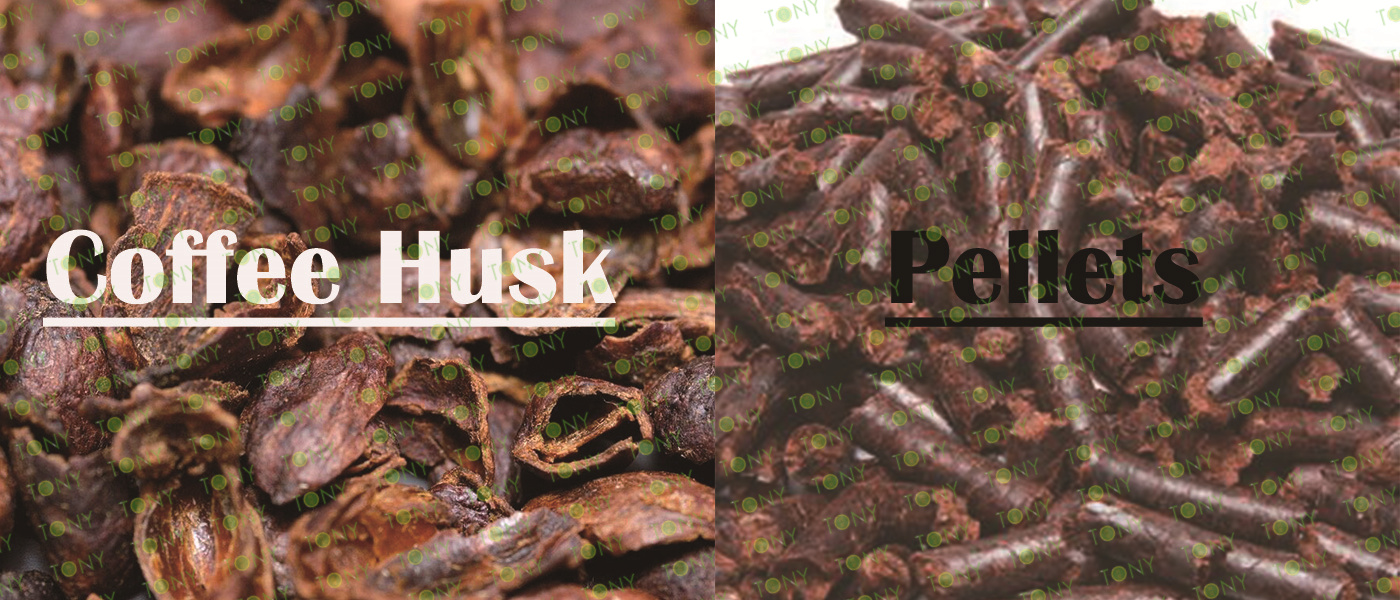


1. Fuel Field:
Advantages: As a kind of biomass fuel, coffee husk pellet particles have high calorific value and combustion efficiency, and produce less pollutants after burning. They belong to clean and renewable energy. Under the background of increasingly strict environmental protection policies and people's increasing demand for clean energy, coffee husk pellet particle fuel, as a substitute for traditional energy sources such as coal and natural gas, has huge market potential. For example, some small factories and boiler rooms have a greater demand for this low-cost biomass fuel.
Challenges: The fuel market is highly competitive and needs to compete with other biomass fuels such as husk particles and sawdust particles. At the same time, the collection, storage and transportation costs of biomass fuels are relatively high, which may affect their promotion and application in some areas.
2. Feed Field:
Advantages: Coffee husk pellet contain certain nutrients such as crude protein, cellulose, fat and various vitamins. After processing, they can be used as raw materials for animal feed. With the development of animal husbandry, the demand for feed is increasing. As a new type of feed raw material, coffee husk pellet particle feed has broad market prospects. Moreover, using coffee husk pellet to produce feed can reduce feed costs and improve the nutritional value of feed.
Challenges: The feed industry has high requirements for the quality and safety of raw materials. Coffee husk pellet need to be strictly screened and processed to ensure the quality and safety of feed. At the same time, brand competition in the feed market is fierce, and a good brand image and sales channels need to be established.
3. Fertilizer Field:
Advantages: After fermentation and other treatments, coffee husk pellet particles can be used as organic fertilizer, which can improve soil structure and increase soil fertility. With people's attention to organic agriculture and the increasing demand for green and environmentally friendly fertilizers, the market prospect of coffee husk pellet particle fertilizer is also relatively broad.
Challenges: The fertilizer market is also highly competitive. It is necessary to continuously improve the quality and effect of fertilizers to meet the needs of farmers. At the same time, a lot of energy and funds need to be invested in fertilizer sales channels and market promotion.

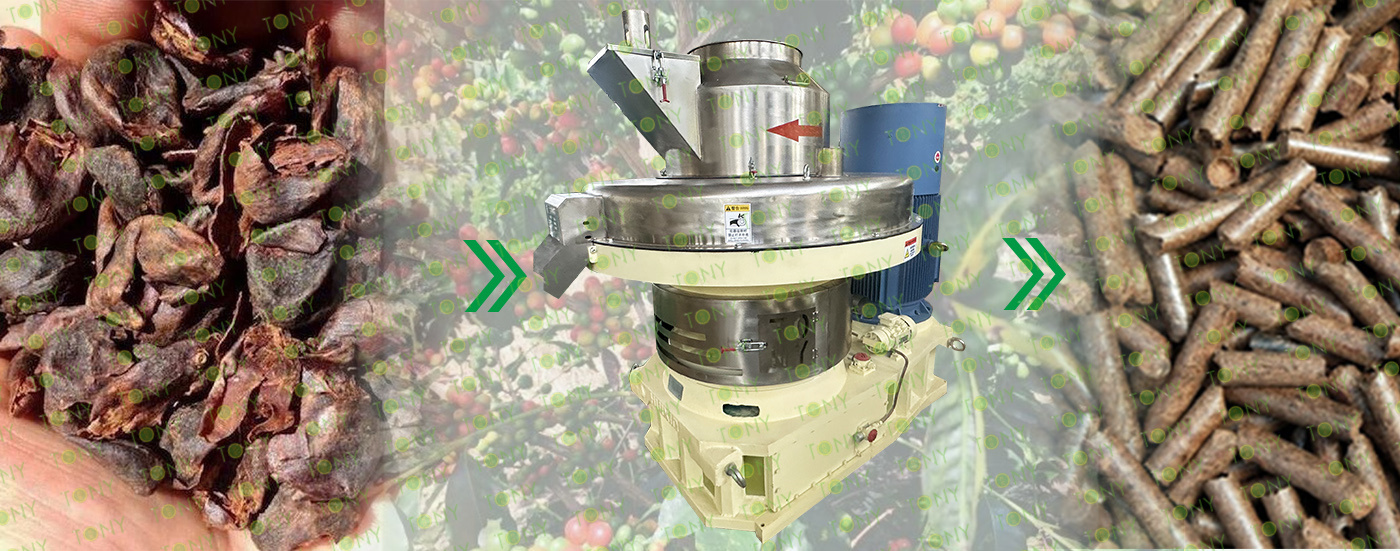
1. Drying Principle
First of all, coffee husk needs to be dried. This is because fresh coffee husk contains a large amount of moisture. Direct processing will lead to problems such as mildew and is not conducive to subsequent molding and storage. Usually, natural drying or the use of special drying equipment such as hot air dryers is adopted. During the drying process, moisture gradually diffuses from the inside of the coffee husk to the surface and is then taken away by means of air convection. When the moisture content of coffee husk is reduced to a certain extent (generally around 10% - 15%), it becomes easier to handle and lays the foundation for subsequent granulation.
2. Crushing Principle
Dried coffee husk needs to be crushed. This is to make the particle size of coffee husk more uniform and facilitate subsequent molding operations. The crushing process generally uses a crusher. Through the action of mechanical force, larger pieces of coffee husk are broken into smaller fragments. The degree of crushing can be adjusted according to the requirements of the final particles. For example, if relatively fine particles are to be made, coffee husk may need to be crushed into powder; if the requirement for particle fineness is not high, the size after crushing can be slightly larger.
3. Bonding And Molding Principle
When making particles, sometimes a binder needs to be added. The role of the binder is to bond the crushed coffee husk fragments together to form a granular shape. Common binders are natural binders such as starch and cellulose. These binders can interact with the components on the surface of coffee husk fragments and make the fragments gather together through physical adsorption or chemical bonding. After the binder and coffee husk fragments are fully mixed, through a specific molding equipment such as a granulator, under the action of certain pressure and shape molds, the mixture is extruded into a granular shape.
4. Drying And Curing Principle
The freshly made particles are still relatively soft and need further drying and curing. This process is similar to the previous drying principle, but the degree and requirements of drying may be different. During the drying and curing process, the moisture inside the particles is further reduced, and the binder will also firmly fix the coffee husk fragments together. At the same time, drying and curing can also improve the strength and stability of the particles, making them better preserved and used. For example, they are not easily broken during storage and can maintain their shape in the soil when used as fertilizer and release nutrients slowly.

TONY Brand 12-15Ton/Hour Coffee Husk pellet manufacturing plant can process Coffee Husk,It is widely used in fertilizer. It can also replace coal for burning.
1.Capacity:12-15Ton/Hour
2.Raw Materials:Rice Husk,Peanut Shell,Sunflower Husk,Coffee Husk,Hazelnut Husk,Walnut Shell,Coconut Shell etc.,etc.
3.Moisture:About 10-15%.
4.Application:Manure compost and animal feed.
5.Finished Pellets Market:Fertilizer and fuel fields.

1.Project Name: Coffee Husk Pellet Line
2.Raw Material: Coffee Husk
3.Moisture Of Raw Material: 10%-15%
4.Capacity: 12-15Ton/Hour
5.Process:1.Fine Crushing Process→2.Storage Process→3.Pelleting Process→4.Cooling Process
6.Main Machine: Hammer Mill, Storage Bin,TONY Pellet MachineTYJ760-III-200KW,Pellets Cooler,And Belt Conveyors.
7.Total Power: About 2000KW
8.Need Area: About 800-1000m㎡
9.Project Country: Vietnam
10.Voltage: 220V,50HZ


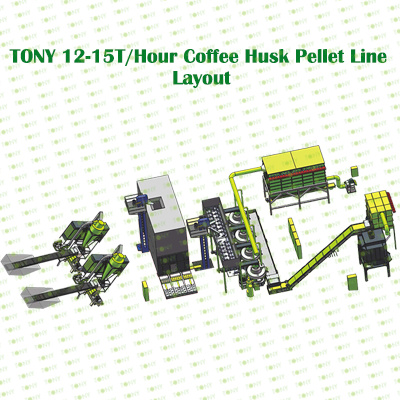 |
Project Layout For Customer |
|
1.Product: Coffee Husk Pellets Line 2.Capacity: 12-15T/Hour 3.TONY Brand 12-15Ton/Hour Coffee Husk Pellet Line Project Process 4.Main Machine:Hammer Mill, Storage Bin,TONY Pellet MachineTYJ760-III-200KW,Pellets Cooler,And Belt Conveyors. 5.Total Power: About 2000KW 6.Need Area: About 800-900m㎡ 7.Country: Vietnam |
|


|
How to use TONY pellet line to proceed from Coffee Husk into pellets? It mainly contains the following steps and machines as following: 1.To Use TONY Hammer Mill To Crush 30-40mm Chips Into 8-14mm Sawdust. 2.To Use TONY Storage Bin To Storage sawdust. 3.To Use TONY Vertical Ring Die Pellet Machine To Products Pellets With φ12-15mm. 4.To Use TONY Galvanized Cooler To Cool Pellets From 80-90℃ to 20-30℃. You can contact TONY to get for more details information and quotation. |
|
||||||||||||||||||||||||||||||||||||||||



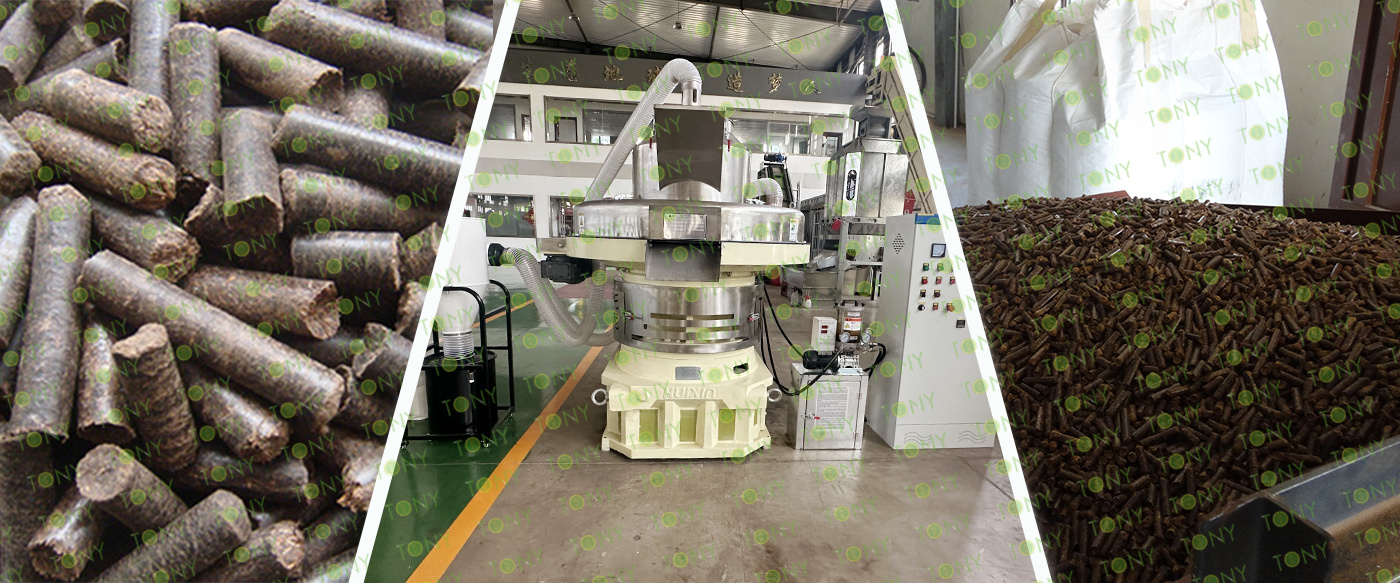
Following TONY Will Introduce For You For All The Necessary Machinery That Will Be Used For The Whole Pellet Production Line. Some Machines Can Be Custom Made By Customer According To Different Customer's Detailed Demand.Contact TONY For More Details With Quotation And Layout.
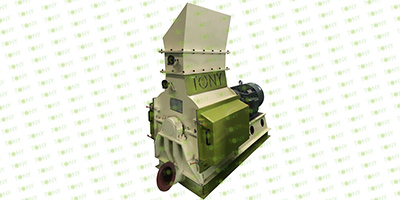 |
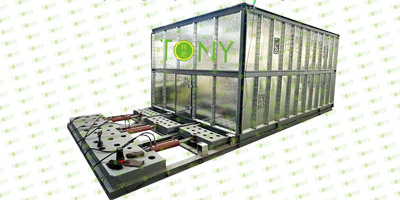 |
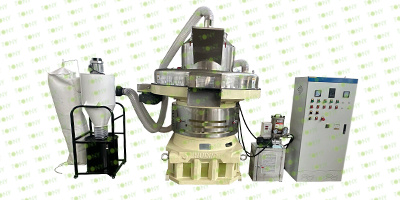 |
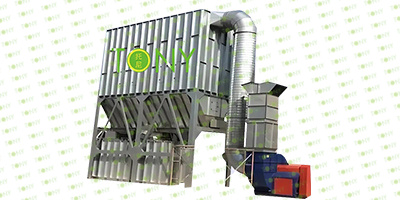 |
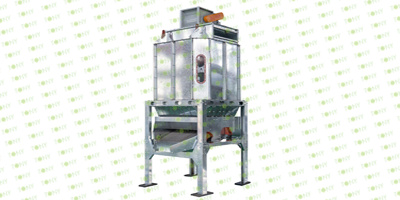 |
| High Efficient Hammer Mill | Stroge Bin | Pellet Machine | Pulse Dust Removal Machine | Cooling Machine |
|
1.Crush 30-40mm Chips Into 8-14mm Sawdust. 2.Model: TFS-75-160-160KW *2Sets 3.Capacity:12-15Ton/Hour/Set Total Capacity:12-15Ton/Hour |
1.To Storage 8-14mm Sawdust With Galvanized 2.Model: TYC120 3.Size:8*2.58*4.58m 4.Size And Cube Can Be Custom-Made |
1.Model: TYJ760-III-200KW*4 Sets 2.Capacity: 3-3.5Ton/Hour/Set 3.Total Capacity:12-15Ton/Hour |
1.Model: TMC-120 2. It can effectively remove dust and exhaust gas generated in the particle production process . |
1.To Cool Pellets From 80-90℃ to 20-30℃ 2.Model:TCN-6 3.Capacity:12-15Ton/Hour |

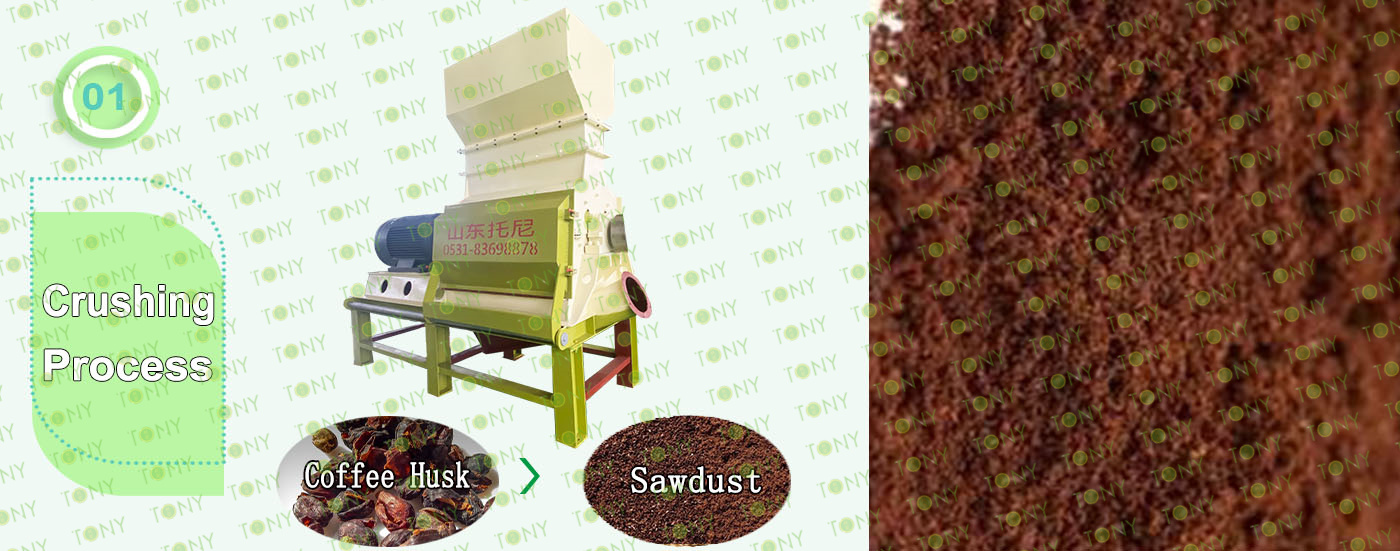
|
1.Husk Fine Crushing Process: A.This process is mainly used to crush 30-40mm coffee husk Into 8-14mm sawdust. B.Capacity:12-15Ton/Hour. C.TONY use High Effective Hammer Mill TFD75-160-160KW-2Set for this process. Main Parts: (1). TONY High Effective Hammer Mill. (2). 120 Holes Pulse Dust Removal. (3). Sawdust Transportation Fan Blower. (4). Cyclone With Airlock. (5). Electrical Cabinets. |
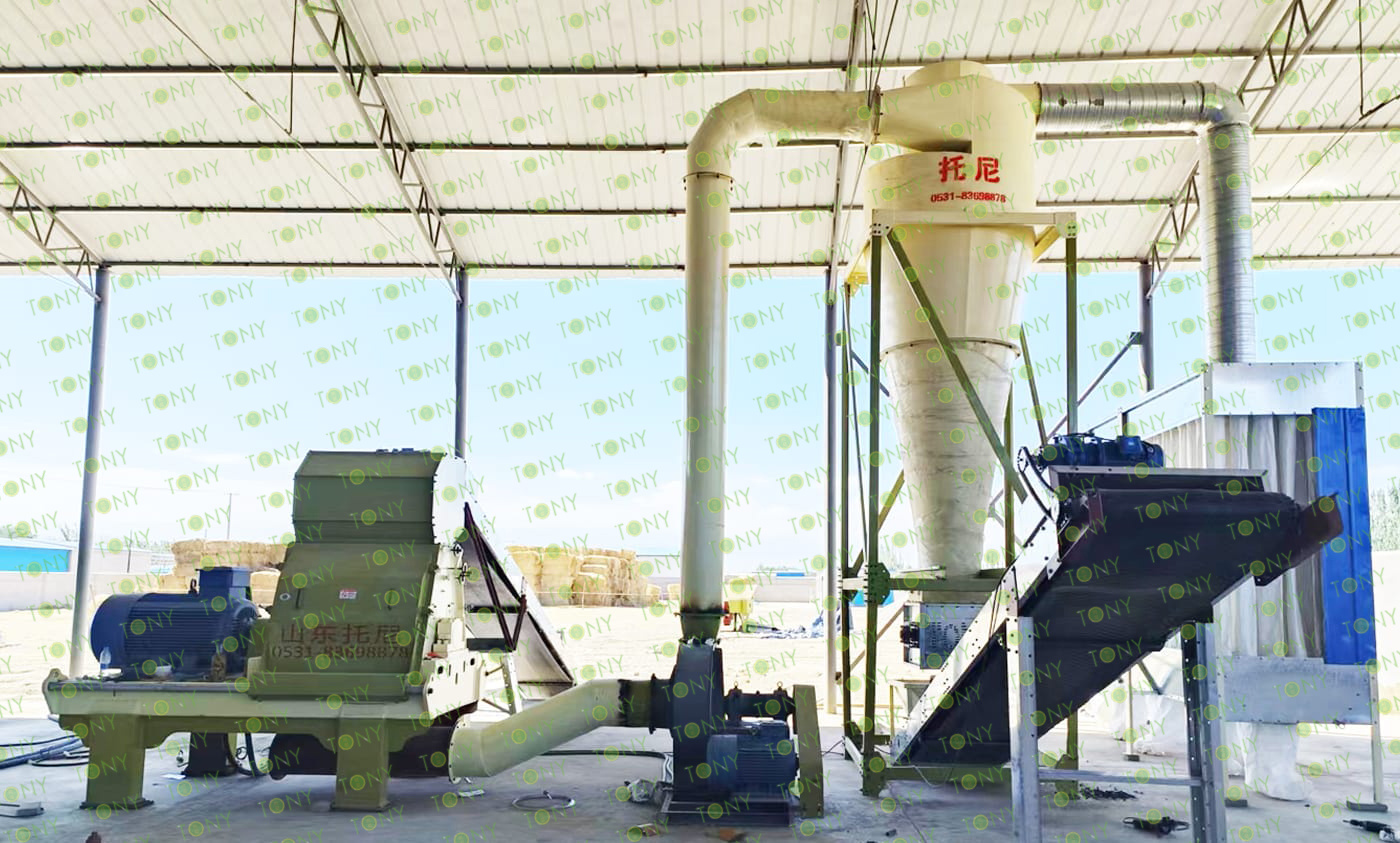

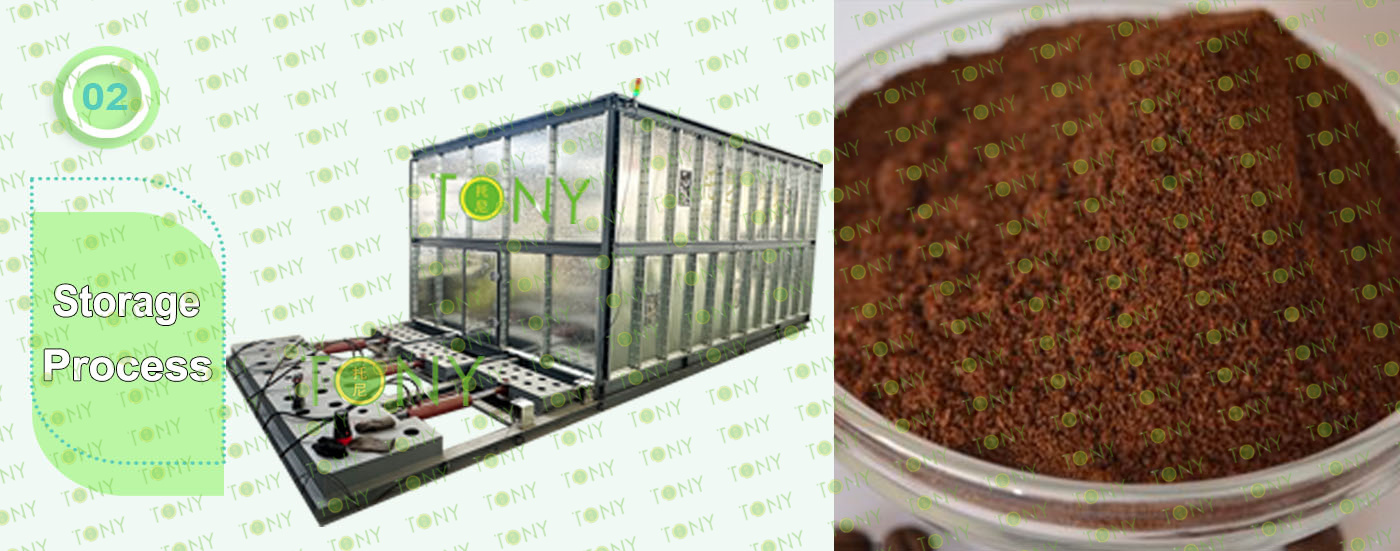
2.Sawdust Storage Process:
A.This process is mainly used to storage coffee husk powder that comes out of the Hammer Mill.It is Hydraulic galvanized storage bin which is more stalbe and coffee husk powder in it is not easy to be blocked.
B.The customer choose one TONY Brand Sawdust Storage to storage the coffee husk powder that comes out of the hammer mill.This process can be optional by customer.If customer donot choose the storage bin,he can storage the coffee husk powder on the ground directly which may need some labour.
Main Parts:
(1).TONY's new Sawdust Storage Bin.
(2).With screws inside the Storage Bin to prevent coffee husk powder from being blocked.
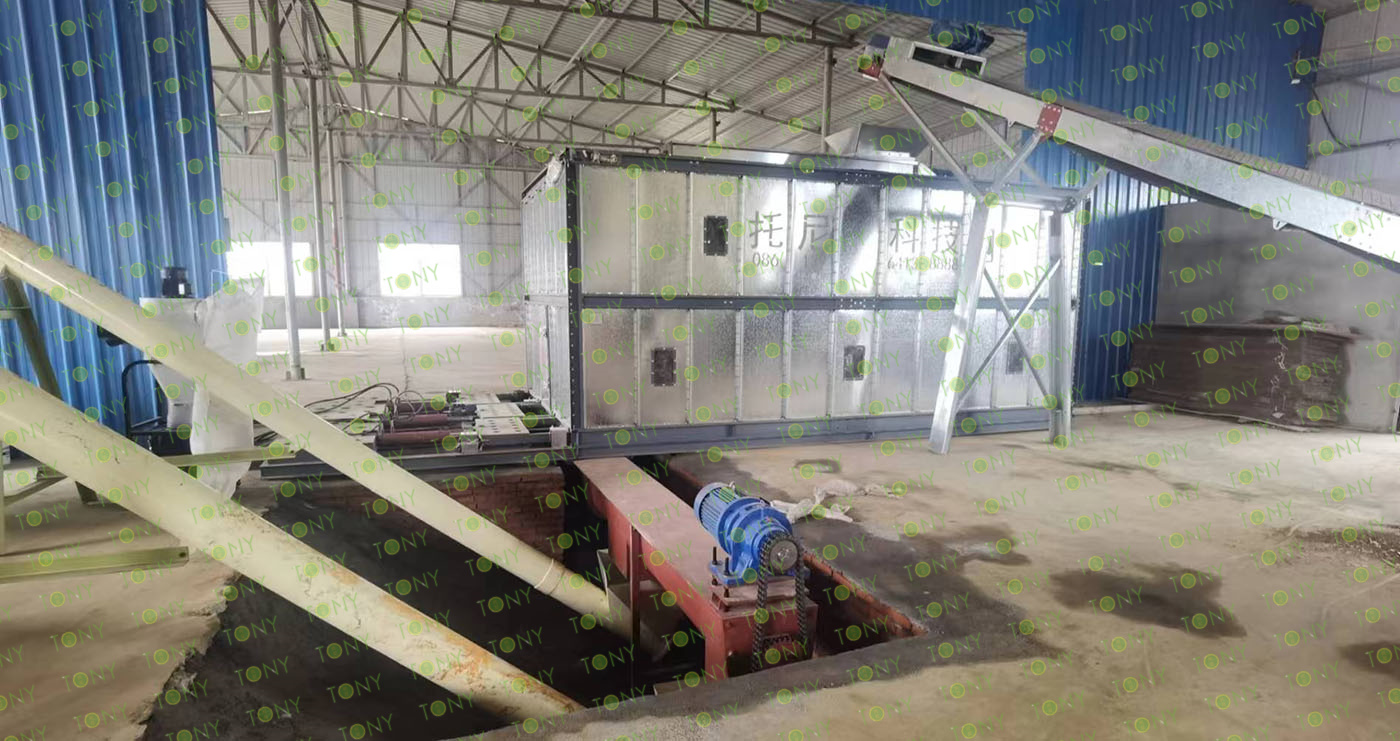

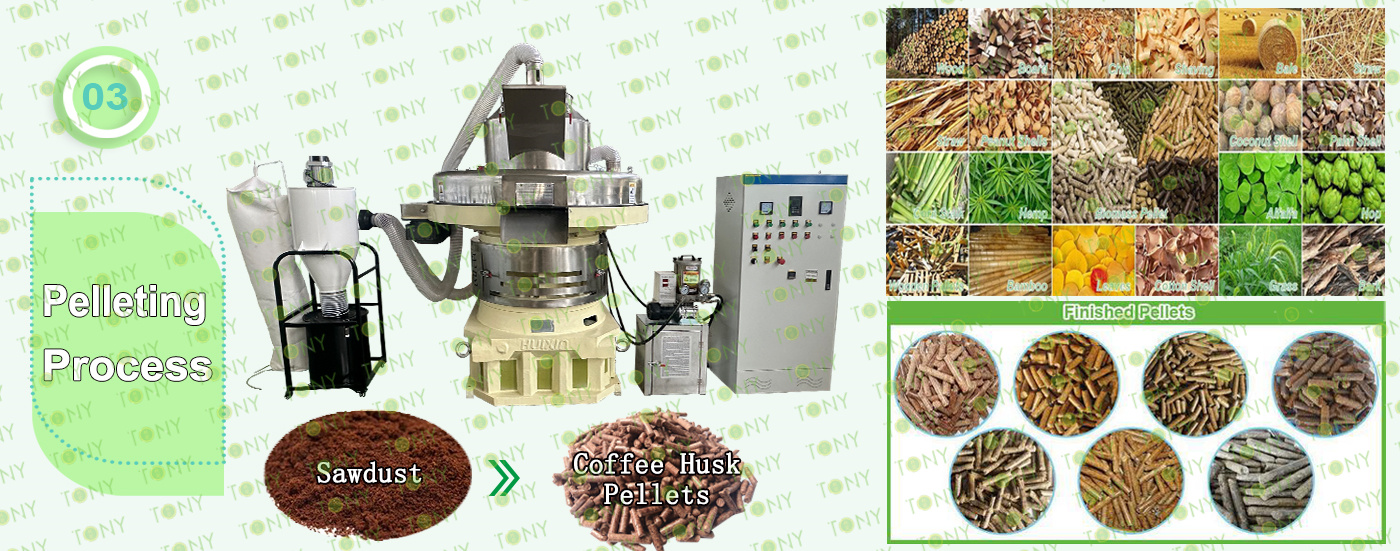
| 3.Pelleting Process:
A.This process is mainly used to product pellets with φ12-15mm. B.Capacity:12-15Ton/Hour. C.The customer chose 4 sets of TONY Brand Vertical Ring Die Pellet Machine TYJ760-III-200k with capacity 3-3.5Ton/Hour. Main Parts: (1). TONY's new vertical ring die pellet machine. (2). 60Holes Pulse dust removal. (3). Bearings automatic lubrication system. (4). Electrical cabinets. You can choose TONY new type SS304 pellet machine or old type MS pellet machine. |
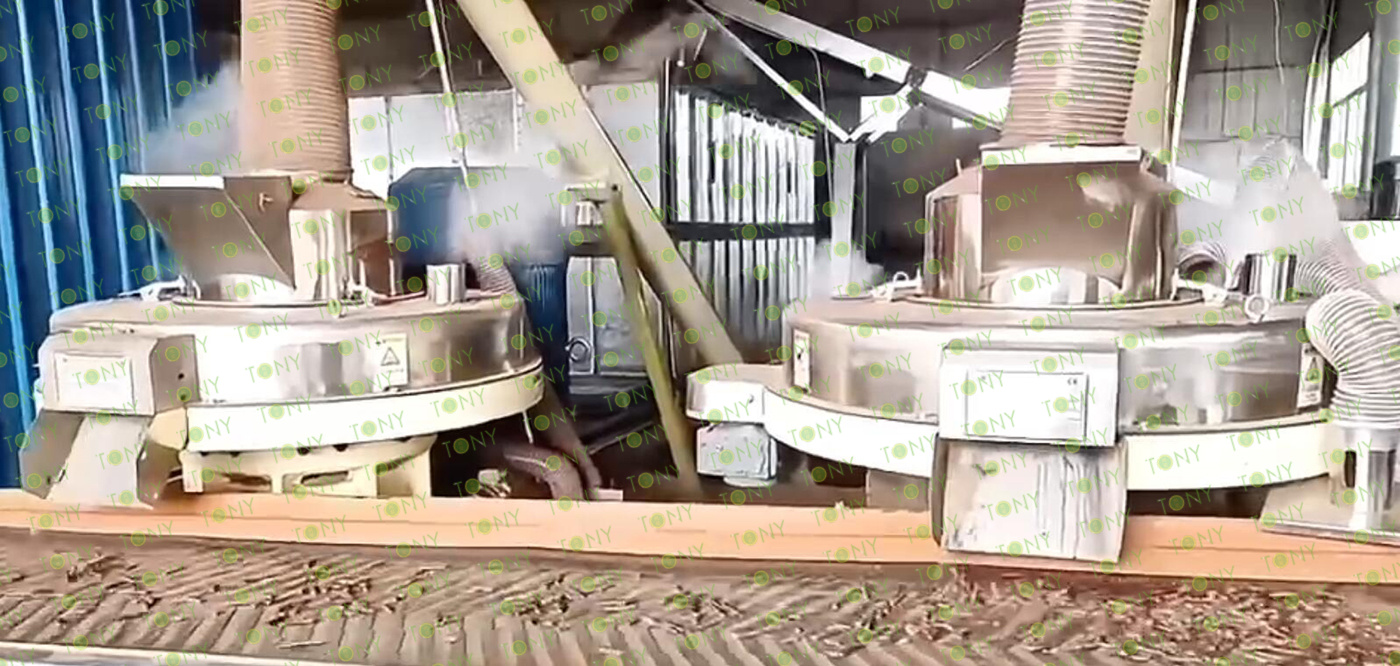

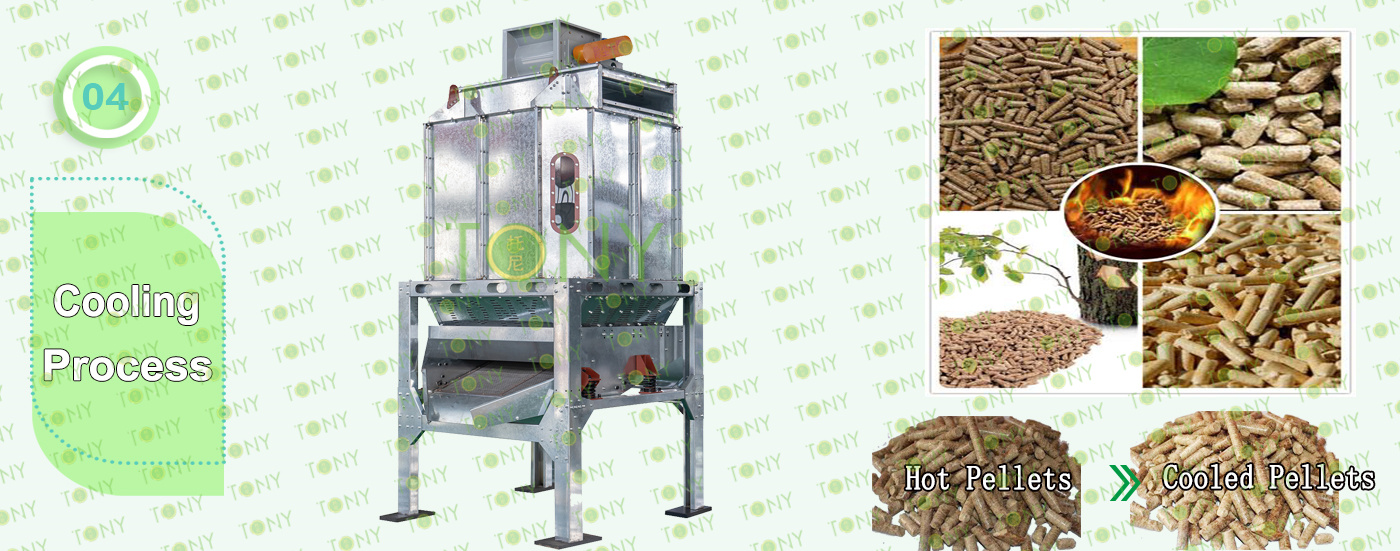
4.Cooling Process:
A.This process is mainly used to to cool pellets from 80-90℃ to 20-30℃
B.The customer chose 1 set of TONY Galvanized Cooler Separator with capacity 12-15Ton/Hour.
Main Parts:
(1). TONY's new Galvanized Cooler Separator with Vibrating Screen.
(2). Cyclone and bags dust collectors.
(3). Fan Blower.
(4). Connect Pipes.
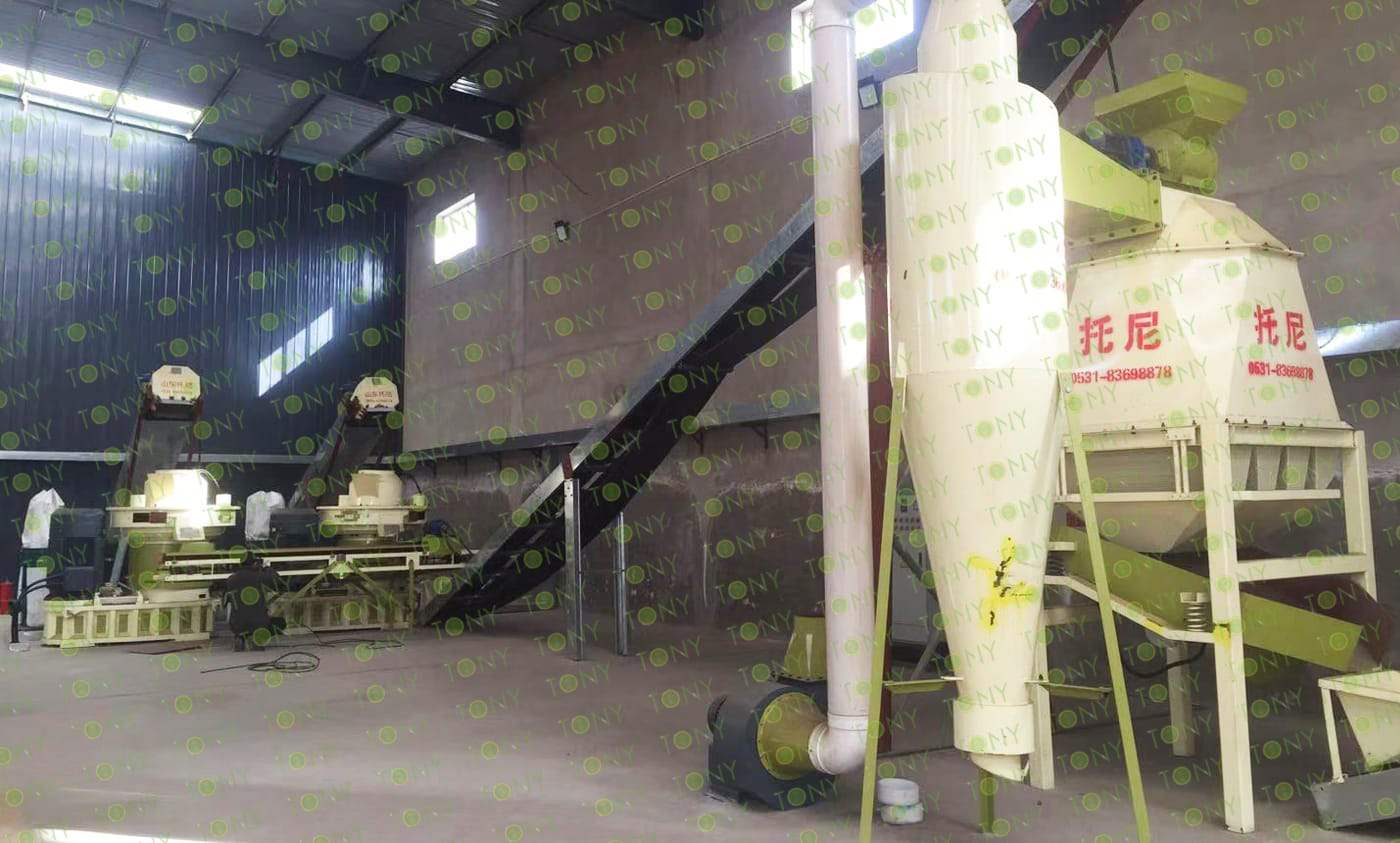

TONY Detailed Design 3D Layout With Detailed Size For 12-15Ton/Hour Coffee Husk Pellet Line According To Cusomer Factor Size
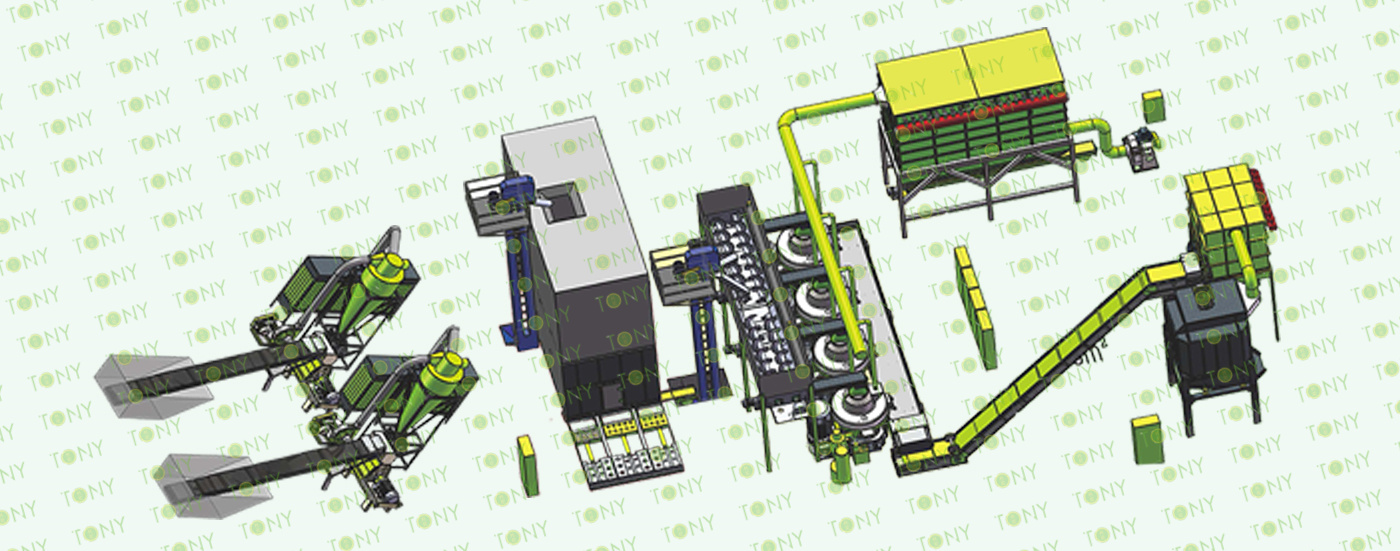

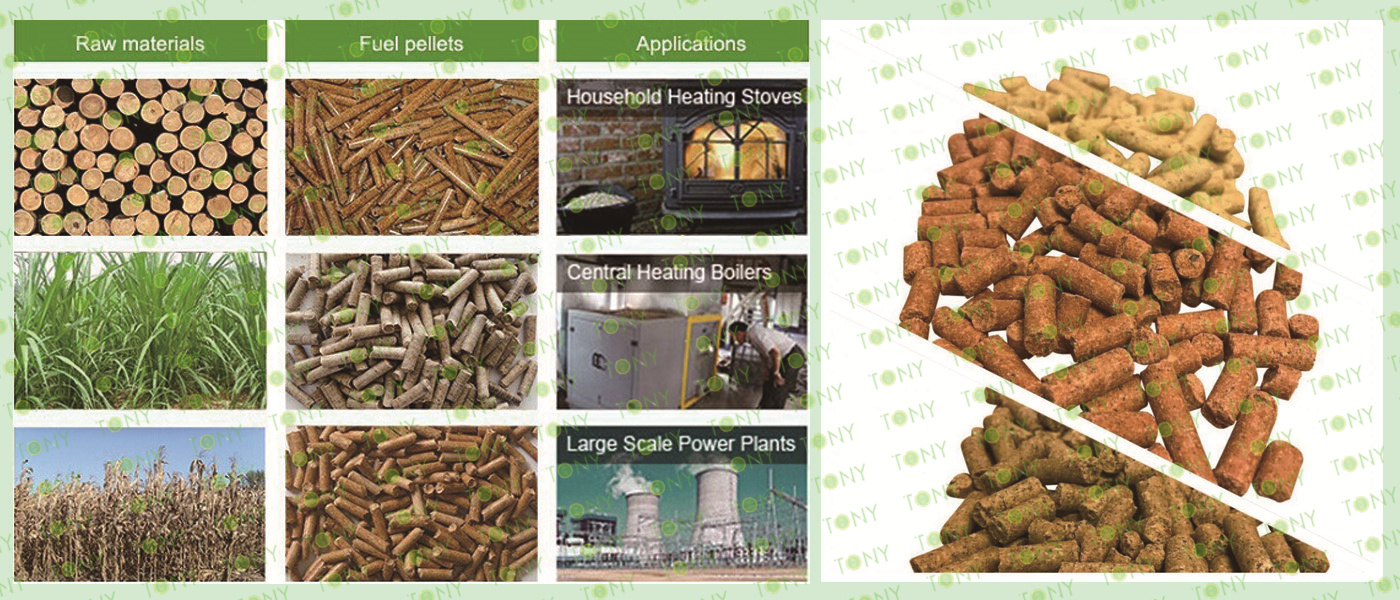
1.Environmental Protection
Waste Reuse: Coffee shells are originally waste from the coffee processing process. Making them into particles can effectively reduce garbage accumulation, reduce environmental pollution, realize resource recycling, and is in line with the concept of sustainable development.
Reduce Carbon Emissions: Compared with traditional fossil fuels, coffee shell particles emit significantly less greenhouse gases such as carbon dioxide during production and use. According to relevant research, the use of biopellet fuel can significantly reduce carbon emissions and help alleviate global climate warming.
2.Energy Utilization
High Calorific Value: Coffee shell particles have a high calorific value and can generate a large amount of heat energy. For example, in the processes of drying fresh coffee fruits and drying tea leaves, it can be used as an efficient fuel to provide stable and sufficient heat to meet production needs.
Renewability: As a widely grown and consumed beverage, coffee husks come from stable and sustainable sources. As long as the coffee industry exists, there will be a continuous supply of coffee shells that can be processed into pellet fuel. There is no need to worry about resource depletion. It is an ideal renewable energy source.
3.Economic Value
Cost-Effectiveness: For coffee production companies, turning coffee shells into pellet fuel not only solves the problem of waste disposal, but also reduces the company's energy costs. Taking Pu'er Outlet Coffee Co., Ltd. as an example, using coffee shell pellets as fuel instead of coal can save nearly 100 yuan per ton.
Employment Creation And Industria Expansion: The production, processing and sales of coffee shell particles can create a large number of employment opportunities and promote the development of the local economy. At the same time, it also provides new direction and motivation for the diversified development of the coffee industry. For example, Pu'er Outlet Coffee Co., Ltd. invested in the construction of a new factory to produce bio-pellet fuel, further enriching the coffee industry format.

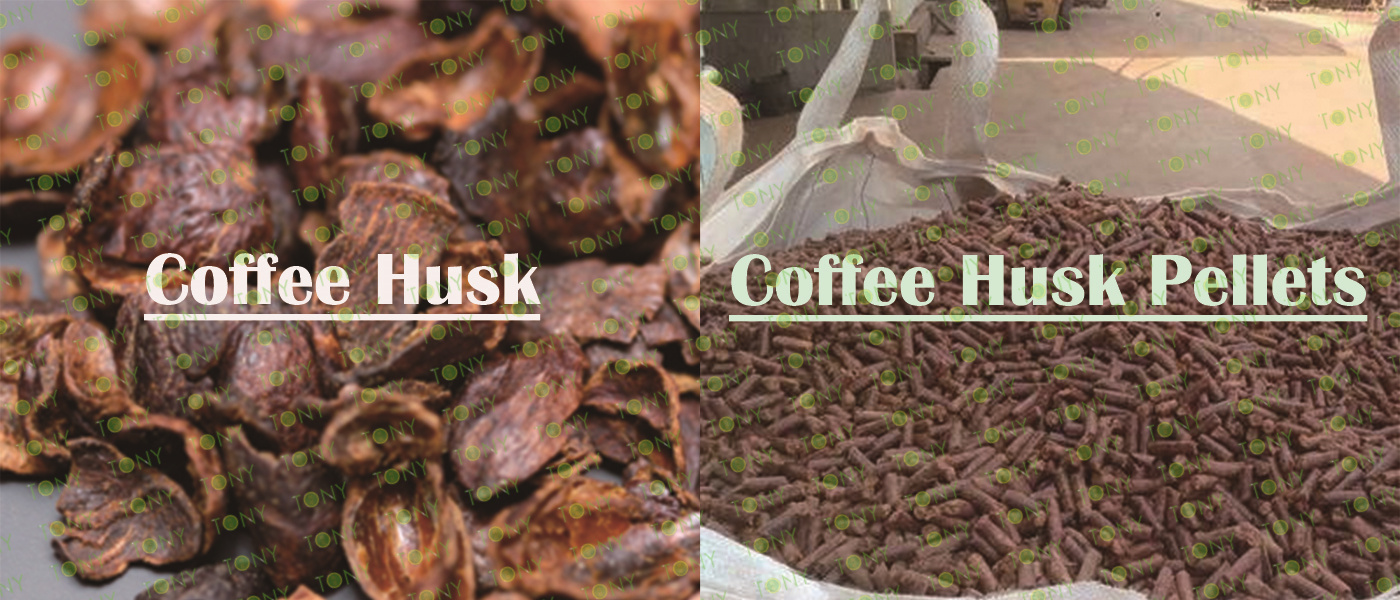
1.Energy Field
Growing Demand For Renewable Energy: With the increasing global attention to environmental protection and sustainable development, the renewable energy market is showing a rapid growth trend. Coffee shell particles, as a biomass energy source, are renewable and low-carbon, and can meet the market's demand for clean energy. They can be used to replace traditional fossil fuels such as coal and oil, and occupy a certain share in energy supply.
Wide Range Of Applications: Coffee shell particles can be used in many fields, such as power generation, heating, industrial production, etc. In the field of power generation, it can be used as fuel for biomass power plants. Compared with other biomass fuels, coffee shell particles have higher calorific value and stability, which can improve power generation efficiency; in the field of heating, it can be used for residential heating, hot water supply, etc., to provide users with clean and efficient thermal energy; in industrial production, it can be used for drying, heating and other processes to reduce the energy costs of enterprises.
2.Agricultural Field
Market Demand For Organic Fertilizers: As people pay more attention to food safety and environmental protection, the development of organic agriculture has received more and more attention. The ash after burning coffee shell particles contains rich nutrients, such as potassium, phosphorus, calcium, etc., which can be used as high-quality organic fertilizer for agricultural production, which can improve soil fertility, improve soil structure, and promote the growth of crops. The market demand for organic fertilizers is increasing, which provides a broad market space for the application of coffee shell particles in the agricultural field.
Additives For Animal Feed: Coffee shell particles contain a certain amount of nutrients such as protein and cellulose. After proper treatment, they can be used as additives for animal feed, which can improve the immunity and production performance of animals. They have certain market potential in the field of animal breeding.
3.Environmental Protection Field
Waste Treatment And Resource Recovery: The coffee industry produces a large amount of coffee shell waste every year. If it is not handled properly, it will cause certain pollution to the environment. Making coffee shells into particles can not only solve the problem of waste disposal, but also achieve resource recycling, reduce pressure on the environment, meet the requirements of environmental protection policies, and have good environmental and social benefits.
Application Of Adsorption Materials: Coffee shell particles have a large specific surface area and pore structure, and have good adsorption properties. They can be used as adsorption materials in wastewater treatment, air purification and other fields. They can adsorb pollutants such as heavy metal ions and organic matter in water, as well as harmful gases in the air, such as sulfur dioxide and nitrogen oxides. The market demand for environmentally friendly adsorption materials continues to increase, providing new market opportunities for the application of coffee shell particles in the field of environmental protection.

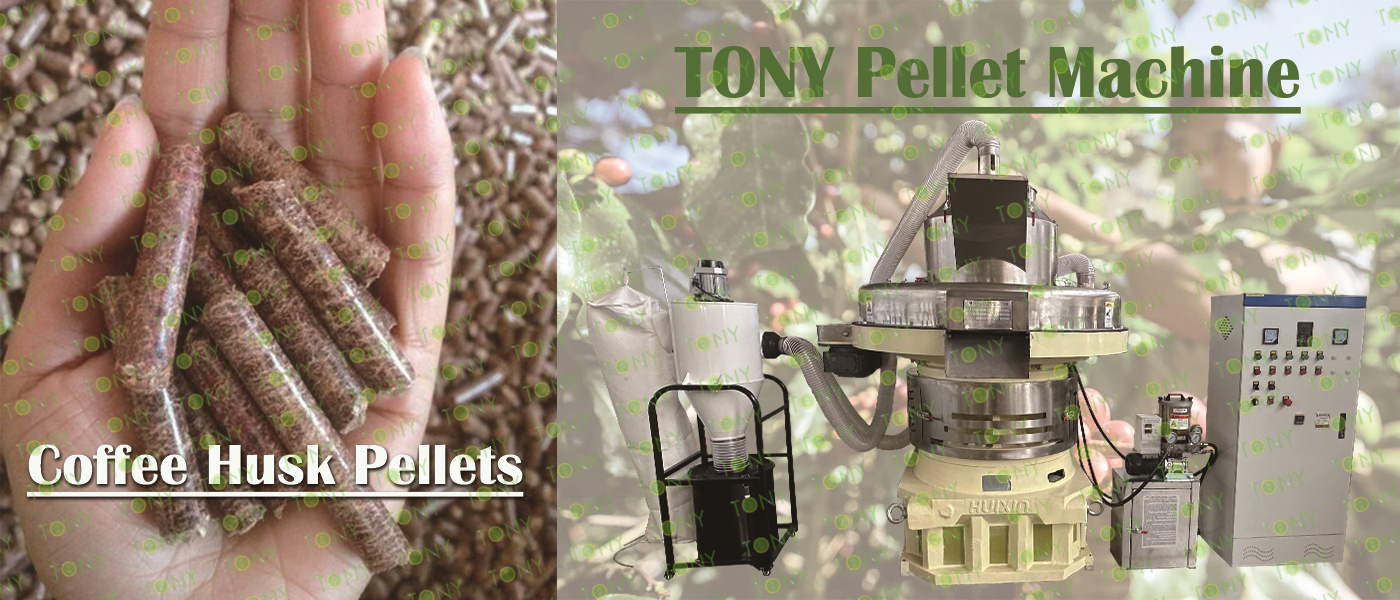
1. With the increasing energy and environmental crisis, biomass energy has been paid more and more attention as a renewable and clean energy. Taking coffee husk as an example, the deep exploitation potential is very great. Biomass utilization can be divided into many kinds, and processing biomass into compressed pellet fuel is an advanced biomass utilization way. The content of S in biomass pellet fuel is less than 1/10 of coal, and its replacement of coal combustion can effectively reduce the emission of SO2 in the atmosphere, and the ash generated after combustion is an excellent natural fertilizer. At present, biomass pellet gasification combustion is a clean and environmentally friendly combustion mode, which is of great significance to reduce pollution emissions and protect the atmospheric environment.
2. As a very important agricultural resource in agricultural production, Coffee husk is very common in rural areas and the amount is very huge, there has been no good treatment method, if the on-site incineration, then it will cause pollution to the environment, and choose Coffee husk as raw materials for biomass particles, there is a very low raw material cost. If there is a large amount of wheat resources in or around it, it is equivalent to zero raw material costs.
3. Biomass fuel is not only environmentally friendly but also provides a choice for the country's energy needs. The market demand for biomass fuel is increasing, and the price of biomass pellet energy made of Coffee husk is also steadily increasing. For entrepreneurial projects, there is a very considerable profit margin. Therefore, the use of Coffee husk to produce biomass pellets is multiple. In addition to protecting the environment and helping to solve employment problems, there are considerable economic and energy sustainability.

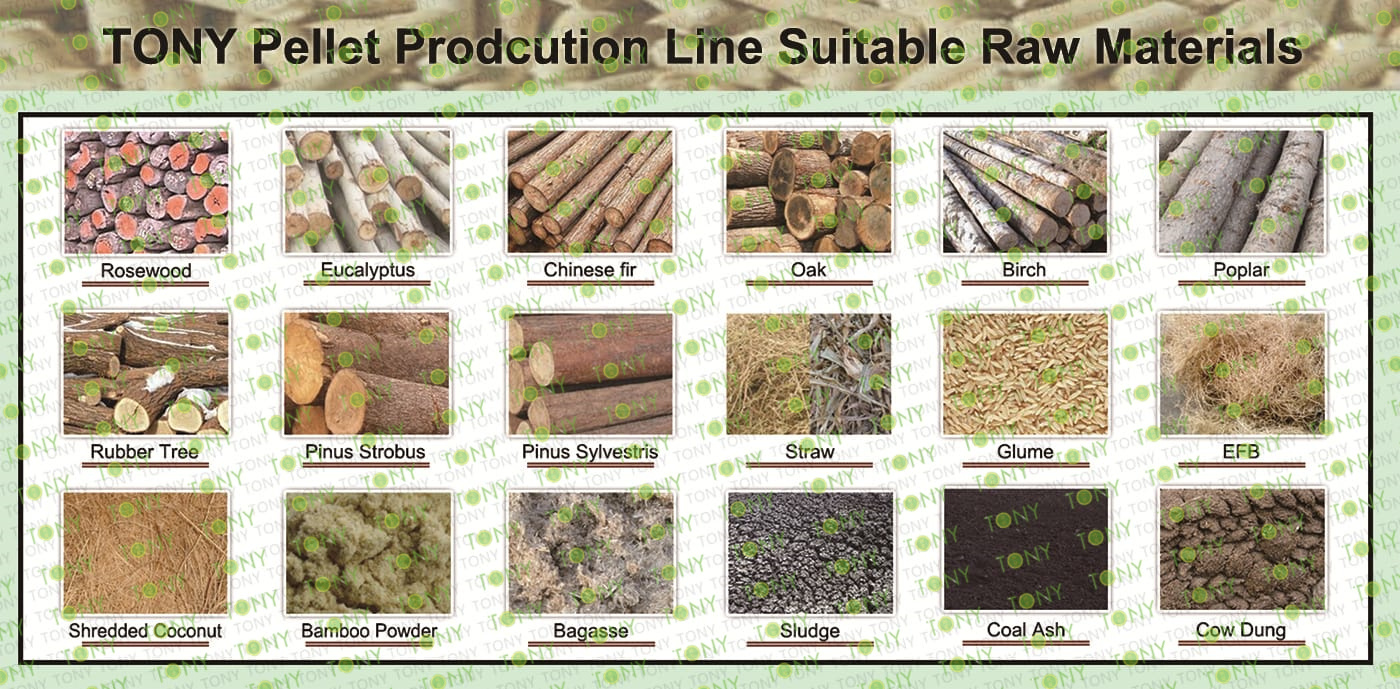
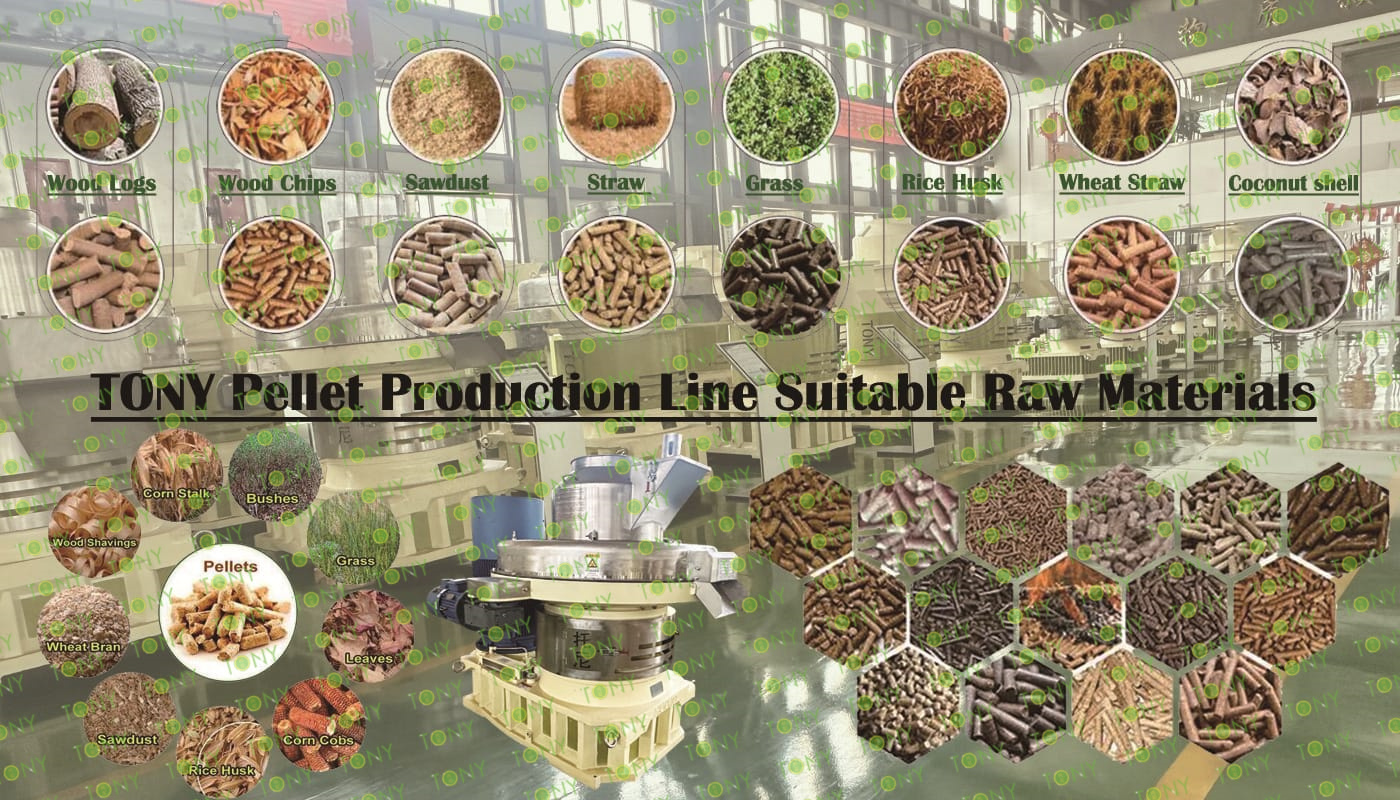



SHANDONG TONY ENVIRONMENTAL PROTECTION SCI-TECH CO.,LTD is an integrated enterprise specializing in developing, anufac-turing and international trade of pellet equipments for over 20 years.
Main products are biomass ring die and flat die pellet machine,biomass pellet line, feed pellet machine, drying, crushing equipments,cooling and ton packing machine.
Looking to the future, we sincerely hope to establish a long-term reliable cooperation relationship with clients all over the world!
TONY is a professional manufacture for biomass pellet machine,pellet production line in Vietnamfor over twenty years.Main products are biomass ring die and flat die pellet machine,biomass pellet line, feed pellet machine, drying, crushing equipments,cooling and ton packing machine.
The new pellet machine adopts stainless steel material ,with high capacity and lower consumption ,which is highly pressed by domestic and abroad all over the world.

2025 Tony Machinery - All Rights Reserved. Map